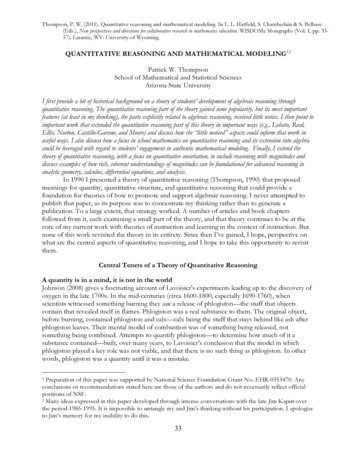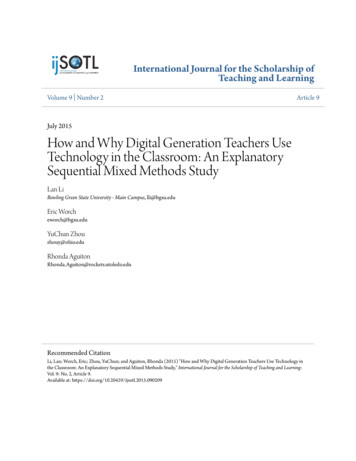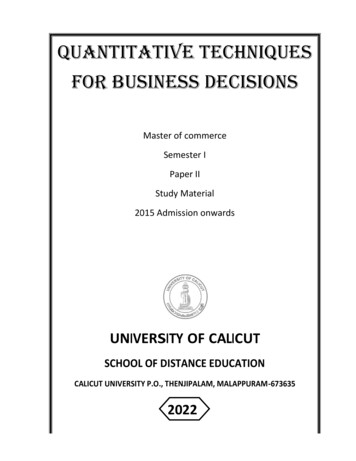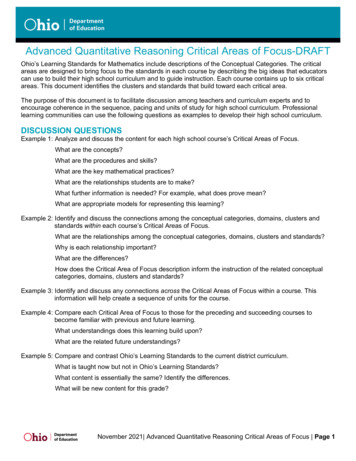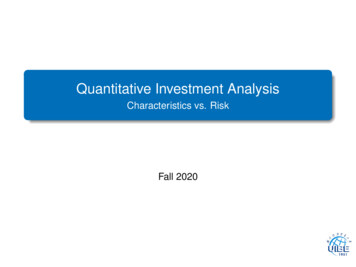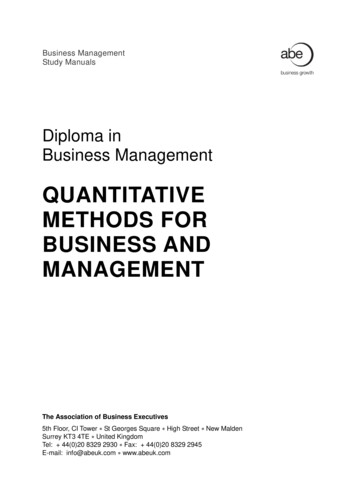
Transcription
Business ManagementStudy ManualsDiploma inBusiness ManagementQUANTITATIVEMETHODS FORBUSINESS ANDMANAGEMENTThe Association of Business Executives5th Floor, CI Tower St Georges Square High Street New MaldenSurrey KT3 4TE United KingdomTel: 44(0)20 8329 2930 Fax: 44(0)20 8329 2945E-mail: info@abeuk.com www.abeuk.com
Copyright, 2008The Association of Business Executives (ABE) and RRC Business TrainingAll rights reservedNo part of this publication may be reproduced, stored in a retrieval system, or transmitted inany form, or by any means, electronic, electrostatic, mechanical, photocopied or otherwise,without the express permission in writing from The Association of Business Executives.
Diploma in Business ManagementQUANTITATIVE METHODS FOR BUSINESS ANDMANAGEMENTContentsUnitTitlePage1Data and Data CollectionIntroductionMeasurement Scales and Types of DataCollecting Primary DataCollecting Secondary Data1235102Sampling ProceduresIntroductionStatistical InferenceSamplingSampling MethodsChoice of Sampling Method1314151618233Tabulating and Graphing Frequency DistributionsIntroductionFrequency DistributionsClass Limits and Class IntervalsCumulative and Relative Frequency DistributionsWays of Presenting Frequency DistributionsPresenting Cumulative Frequency Distributions252627293234424Measures of LocationIntroductionUse of Measures of LocationMeansMedianQuantilesModeChoice of MeasureAppendix: Functions, Equations and Graphs4749495056596264655Measures of DispersionIntroductionRangeQuartile DeviationStandard Deviation and VarianceCoefficient of VariationSkewness71727374757980
UnitTitlePage6Index NumbersIntroductionSimple (Unweighted) Index NumbersWeighted index Numbers (Laspeyres and Paasche Indices)Fisher's Ideal IndexFormulaeQuantity or Volume Index NumbersChanging the Index Base YearIndex Numbers in Practice7CorrelationIntroductionScatter DiagramsThe Correlation CoefficientRank Correlation1031041041081128Linear RegressionIntroductionRegression LinesUse of RegressionConnection Between Correlation and RegressionMultiple Regression1191201211251261269Time Series AnalysisIntroductionStructure of a Time SeriesCalculation of Component Factors for the Additive ModelMultiplicative ModelForecastingThe Z nTwo Laws of ProbabilityPermutationsCombinationsConditional ProbabilitySample SpaceVenn Diagrams15315515615916216416516711Binomial and Poisson DistributionsIntroductionThe Binomial DistributionApplications of the Binomial DistributionMean and Standard Deviation of the Binomial DistributionThe Poisson DistributionApplication of the Poisson DistributionPoisson Approximation to a Binomial DistributionApplication of Binomial and Poisson Distributions – Control ChartsAppendix: The Binomial 0919495
UnitTitlePage12The Normal DistributionIntroductionThe Normal DistributionUse of the Standard Normal TableGeneral Normal ProbabilitiesUse of Theoretical DistributionsAppendix: Standard Normal Table – Area under the Normal Curve21321421421922122222613Significance TestingIntroductionIntroduction to Sampling TheoryConfidence IntervalsHypothesis TestsSignificance LevelsSmall Sample Tests22722822923123324024114Chi-squared TestsIntroductionChi-squared as a Test of IndependenceChi-squared as a Test of Goodness of FitAppendix: Area in the Right Tail of a Chi-squared (χ2) uctionDecision-making Under CertaintyDefinitionsDecision-making Under UncertaintyDecision-making Under RiskComplex Decisions25926026026126226426716Applying Mathematical Relationships to Economic and BusinessProblemsUsing Linear Equations to Represent Demand and Supply FunctionsThe Effects of a Sales TaxBreakeven AnalysisBreakeven ChartsThe Algebraic Representation of Breakeven Analysis273274279280282287
1Study Unit 1Data and Data CollectionContentsPageA.IntroductionThe Role of Quantitative Methods in Business and ManagementStatistics222B.Measurement Scales and Types of DataMeasurement ScalesVariables and Data334C.Collecting Primary DataInterviewsAdvantages of InterviewingDisadvantages of InterviewingSelf-Completion QuestionnairesAdvantages of Self-Completion QuestionnairesDisadvantages of Self-Completion QuestionnairesNon-response Bias and Sampling ErrorPersonal Observation556678999D.Collecting Secondary DataScanning Published DataInternal Data SourcesExternal Data SourcesONS PublicationsAnnual Business Inquiry ABE and RRC101011111112
2Data and Data CollectionA. INTRODUCTIONThe Role of Quantitative Methods in Business and ManagementQuantitative methods play an important role both in business research and in the practicalsolution of business problems. Managers have to take decisions on a wide range of issues,such as: how much to produce what prices to charge how many staff to employ whether to invest in new capital equipment whether to fund a new marketing initiative whether to introduce a new range of products whether to employ an innovative method of production.In all of these cases, it is clearly highly desirable to be able to compute the likely effects ofthe decisions on the company's costs, revenues and, most importantly, profits. Similarly, it isimportant in business research to be able to use data from samples to estimate parametersrelating to the population as a whole (for example, to predict the effect of introducing a newproduct on sales throughout the UK from a survey conducted in a few selected regions).These sorts of business problems require the application of statistical methods such as: time-series analysis and forecasting correlation and regression analysis estimation and significance testing decision-making under conditions of risk and uncertainty break-even analysis.These methods in turn require an understanding of a range of summary statistics andconcepts of probability. These topics therefore form the backbone of this course.StatisticsMost of the quantitative methods mentioned above come under the general heading ofstatistics. The term "statistics" of course is often used to refer simply to a set of data – so, forexample, we can refer to a country's unemployment statistics (which might be presented in atable or chart showing the country's unemployment rates each year for the last few years,and might be broken down by gender, age, region and/or industrial sector, etc.). However,we can also use the term "Statistics" (preferably with a capital letter) to refer to the academicdiscipline concerned with the collection, description, analysis and interpretation of numericaldata. As such, the subject of Statistics may be divided into two main categories:(a)Descriptive StatisticsThis is mainly concerned with collecting and summarising data, and presenting theresults in appropriate tables and charts. For example, companies collect andsummarise their financial data in tables (and occasionally charts) in their annualreports, but there is no attempt to go "beyond the data". ABE and RRC
Data and Data Collection(b)3Statistical InferenceThis is concerned with analysing data and then interpreting the results (attempting togo "beyond the data"). The main way in which this is done is by collecting data from asample and then using the sample results to infer conclusions about the population.For example, prior to general elections in the UK and many other countries,statisticians conduct opinion polls in which samples of potential voters are asked whichpolitical party they intend to vote for. The sample proportions are then used to predictthe voting intentions of the entire population.Of course, before any descriptive statistics can be calculated or any statistical inferencesmade, appropriate data has to be collected. We will start the course, therefore, by seeinghow we collect data. This study unit looks at the various types of data, the main sources ofdata and some of the numerous methods available to collect data.B. MEASUREMENT SCALES AND TYPES OF DATAMeasurement ScalesQuantitative methods use quantitative data which consists of measurements of variouskinds. Quantitative data may be measured in one of four measurement scales, and it isimportant to be aware of the measurement scale that applies to your data beforecommencing any data description or analysis. The four measurement scales are:(a)Nominal ScaleThe nominal scale uses numbers simply to identify members of a group or category.For example, in a questionnaire, respondents may be asked whether they are male orfemale and the responses may be given number codes (say 0 for males and 1 forfemales). Similarly, companies may be asked to indicate their ownership form andagain the responses may be given number codes (say 1 for public limited companies,2 for private limited companies, 3 for mutual organizations, etc.). In these cases, thenumbers simply indicate the group to which the respondents belong and have nofurther arithmetic meaning.(b)Ordinal ScaleThe ordinal scale uses numbers to rank responses according to some criterion, buthas no unit of measurement. In this scale, numbers are used to represent "more than"or "less than" measurements, such as preferences or rankings. For example, it iscommon in questionnaires to ask respondents to indicate how much they agree with agiven statement and their responses can be given number codes (say 1 for "DisagreeStrongly", 2 for "Disagree", 3 for "Neutral", 4 for "Agree" and 5 for "Agree Strongly").This time, in addition to indicating to which category a respondent belongs, thenumbers measure the degree of agreement with the statement and tell us whether onerespondent agrees more or less than another respondent. However, since the ordinalscale has no units of measurement, we cannot say that the difference between 1 and 2(i.e. between disagreeing strongly and just disagreeing) is the same as the differencebetween 4 and 5 (i.e. between agreeing and agreeing strongly).(c)Interval ScaleThe interval scale has a constant unit of measurement, but an arbitrary zero point.Good examples of interval scales are the Fahrenheit and Celsius temperature scales.As these scales have different zero points (i.e. 0 degrees F is not the same as 0degrees C), it is not possible to form meaningful ratios. For example, although we cansay that 30 degrees C (86 degrees F) is hotter than 15 degrees C (59 degrees F), wecannot say that it is twice as hot (as it clearly isn't in the Fahrenheit scale). ABE and RRC
4Data and Data Collection(d)Ratio ScaleThe ratio scale has a constant unit of measurement and an absolute zero point. So thisis the scale used to measure values, lengths, weights and other characteristics wherethere are well-defined units of measurement and where there is an absolute zerowhere none of the characteristic is present. For example, in values measured inpounds, we know (all too well) that a zero balance means no money. We can also saythat 30 is twice as much as 15, and this would be true whatever currency were usedas the unit of measurement. Other examples of ratio scale measurements include theaverage petrol consumption of a car, the number of votes cast at an election, thepercentage return on an investment, the profitability of a company, and many others.The measurement scale used gives us one way of distinguishing between different types ofdata. For example, a set of data may be described as being "nominal scale", "ordinal scale","interval scale" or "ratio scale" data. More often, a simpler distinction is made betweencategorical data (which includes all data measured using nominal or ordinal scales) andquantifiable data (which includes all data measured using interval or ratio scales).Variables and DataAny characteristic on which observations can be made is called a variable or variate. Forexample, height is a variable because observations taken are of the heights of a number ofpeople. Variables, and therefore the data which observations of them produce, can becategorised in various ways:(a)Quantitative and Qualitative VariablesVariables may be either quantitative or qualitative. Quantitative variables, to which weshall restrict discussion here, are those for which observations are numerical in nature.Qualitative variables have non-numeric observations, such as colour of hair, althoughof course each possible non-numeric value may be associated with a numericfrequency.(b)Continuous and Discrete VariablesVariables may be either continuous or discrete. A continuous variable may take anyvalue between two stated limits (which may possibly be minus and plus infinity).Height, for example, is a continuous variable, because a person's height may (withappropriately accurate equipment) be measured to any minute fraction of a millimetre.A discrete variable however can take only certain values occurring at intervals betweenstated limits. For most (but not all) discrete variables, these intervals are the set ofintegers (whole numbers).For example, if the variable is the number of children per family, then the only possiblevalues are 0, 1, 2, . etc., because it is impossible to have other than a whole numberof children. However in Britain shoe sizes are stated in half-units, and so here we havean example of a discrete variable which can take the values 1, 1½, 2, 2½, etc.You may possibly see the difference between continuous and discrete variables statedas "continuous variables are measured, whereas discrete variables are counted".While this is possibly true in the vast majority of cases, you should not simply state thisif asked to give a definition of the two types of variables.(c)Primary and Secondary DataIf data is collected for a specific purpose then it is known as primary data. Forexample, the information collected direct from householders' television sets through amicrocomputer link-up to a mainframe computer owned by a television company isused to decide the most popular television programmes and is thus primary data. TheCensus of Population, which is taken every ten years, is another good example of ABE and RRC
Data and Data Collection5primary data because it is collected specifically to calculate facts and figures in relationto the people living in the UK.Secondary data is data which has been collected for some purpose other than that forwhich it is being used. For example, if a company has to keep records of whenemployees are sick and you use this information to tabulate the number of daysemployees had flu in a given month, then this information would be classified assecondary data.Most of the data used in compiling business statistics is secondary data because thesource is the accounting, costing, sales and other records compiled by companies foradministration purposes. Secondary data must be used with great care; as the datawas collected for another purpose, and you must make sure that it provides theinformation that you require. To do this you must look at the sources of the information,find out how it was collected and the exact definition and method of compilation of anytables produced.(d)Cross-Section and Time-Series DataData collected from a sample of units (e.g. individuals, firms or governmentdepartments) for a single time period is called cross-section data. For example, thetest scores obtained by 20 management trainees in a company in 2007 wouldrepresent a sample of cross-section data. On the other hand, data collected for asingle unit (e.g. a single individual, firm or government department) at multiple timeperiods are called time-series data. For example, annual data on the UK inflation ratefrom 1985–2007 would represent a sample of time-series data. Sometimes it ispossible to collect cross-section over two or more time periods – the resulting data setis called a panel data or longitudinal data set.C. COLLECTING PRIMARY DATAThere are three main methods of collecting primary data: by interviews, by self-completionquestionnaires or by personal observations. These three methods are discussed below.InterviewsInterviewing is a common method of collecting information in which interviewers questionpeople on the subject of the survey. Interviews can be face-to-face or conducted bytelephone. Face-to-face interviews are relatively expensive, but offer the opportunity for theinterviewer to explain questions and to probe more deeply into any answers given. Interviewsby telephone are less personal but can be useful if time is short.Interviews may be structured, semi-structured or unstructured:(a)Structured InterviewsIn a structured interview, the interviewer usually has a well-defined set of preparedquestions (i.e. a questionnaire) in which most of the questions are "closed" (i.e. eachquestion has a predetermined set of options for the response, such as a box to beticked). The design of such questionnaires is essentially the same as that discussedbelow under the heading Self-Completion Questionnaires. Structured interviewing isuseful if the information being sought is part of a clearly-defined business researchproject (such as market research), and if the aim of the survey is to collect numericaldata suitable for statistical analysis.(b)Semi-Structured InterviewsIn a semi-structured interview, the interviewer has a set of prepared questions, but ishappy to explore other relevant issues raised by the interviewee. ABE and RRC
6Data and Data Collection(c)Unstructured InterviewsIn unstructured interviews, the interviewer does not have a set of prepared questionsand the emphasis is often on finding out the interviewee's point of view on the subjectof the survey. Unstructured interviews are more commonly used in qualitative (ratherthan quantitative) research, though they can also be useful as pilot studies, designedto help a researcher formulate a research problem.Advantages of InterviewingThere are many advantages of using interviewers in order to collect information:(a)The major one is that a large amount of data can be collected relatively quickly andcheaply. If you have selected the respondents properly and trained the interviewersthoroughly, then there should be few problems with the collection of the data.(b)This method has the added advantage of being very versatile since a good interviewercan adapt the interview to the needs of the respondent. If, for example, an aggressiveperson is being interviewed, then the interviewer can adopt a conciliatory attitude to therespondent; if the respondent is nervous or hesitant, the interviewer can beencouraging and persuasive.The interviewer is also in a position to explain any question, although the amount ofexplanation should be defined during training. Similarly, if the answers given to thequestion are not clear, then the interviewer can ask the respondent to elaborate onthem. When this is necessary the interviewer must be very careful not to lead therespondent into altering rather than clarifying the original answers. The technique fordealing with this problem must be tackled at the training stage.(c)This face-to-face technique will usually produce a high response rate. The responserate is determined by the proportion of interviews that are successful. A successfulinterview is one that produces a questionnaire with every question answered clearly. Ifmost respondents interviewed have answered the questions in this way, then a highresponse rate has been achieved. A low response rate is when a large number ofquestionnaires are incomplete or contain useless answers.(d)Another advantage of this method of collecting data is that with a well-designedquestionnaire it is possible to ask a large number of short questions in one interview.This naturally means that the cost per question is lower than in any other method.Disadvantages of InterviewingProbably the biggest disadvantage of this method of collecting data is that the use of a largenumber of interviewers leads to a loss of direct control by the planners of the survey.Mistakes in selecting interviewers and any inadequacy of the training programme may not berecognised until the interpretative stage of the survey is reached. This highlights the need totrain interviewers correctly.It is particularly important to ensure that all interviewers ask questions in a similar way. It ispossible that an inexperienced interviewer, just by changing the tone of voice used, may givea different emphasis to a question than was originally intended. This problem will sometimesbecome evident if unusual results occur when the information collected is interpreted.In spite of these difficulties, this method of data collection is widely used as questions can beanswered cheaply and quickly and, given the correct approach, this technique can achievehigh response rates. ABE and RRC
Data and Data Collection7Self-Completion QuestionnairesSelf-completion questionnaires are completed by the respondents with no help from aninterviewer. They may be administered by post, by email or by directing potentialrespondents to a website.The design of a questionnaire will reflect the way in which it is to be used. Many problemscan be avoided by careful design, particularly where the information on the questionnairehas to be transferred to analysis sheets or entered into a computer. For example, if all theresponses are aligned down one side of the sheet it is a great deal easier to read them offthan if they are scattered around the sheet.Overall a questionnaire form should not look too overpowering: good layout can improveresponse considerably. Equally questionnaires should be kept as short as possible (unlessthere is a legal compulsion to fill it in, as with many government surveys), as a multi-pagequestionnaire will probably be put on one side and either forgotten or returned late.The above discussion only touches on a few of the considerations in designing aquestionnaire; hopefully it will make you think about what is involved. Professional help is agood idea when designing a questionnaire.The general principle to keep in mind when designing a set of questions is that, if a questioncan be misread, it will be. Questions must always be tested on someone who was notinvolved in setting them, and preferably on a small sample of the people they will be sent to.Testing a new questionnaire on a small sample of potential respondents is sometimesreferred to as a pilot study.The principles to observe when designing a questionnaire are:(a)Keep it as short as possible, consistent with getting the right results.(b)Explain the purpose of the investigation so as to encourage people to give answers.(c)Individual questions should be as short and simple as possible.(d)If possible, only short and definite answers like "Yes", "No" or a number of some sortshould be called for.(e)Questions should be capable of only one interpretation, and leading questions shouldbe avoided.(f)Where possible, use the "alternative answer" system in which the respondent has tochoose between several specified answers.(g)The questions should be asked in a logical sequence.(h)The respondent should be assured that the answers will be treated confidentially andnot be used to his or her detriment.(i)No calculations should be required of the respondent.You should always apply these principles when designing a questionnaire, and you shouldunderstand them well enough to be able to remember them all if you are asked for them inan examination question. They are principles and not rigid rules – often you have to breaksome of them in order to get the right information. Governments often break these principlesbecause they can make the completion of the questionnaire compulsory by law, but otherinvestigators must follow the rules as far as practicable in order to make the questionnaire aseasy and simple to complete as possible – otherwise they will receive no replies.If the questionnaire is to be used for a structured interview, then the task of collecting theinformation will be entrusted to a team of interviewers. These interviewers must be trained inthe use of the questionnaire and advised how to present it so that maximum cooperation isobtained from the respondent. This training is very important and must be carefully thought ABE and RRC
8Data and Data Collectionout. The interviewers must be carefully selected so that they will be suitable for the type ofinterview envisaged. The type of interviewer and the method of approach must be variedaccording to the type of respondent selected, e.g. the same technique should not be usedfor interviewing students and senior bank staff.What follows is an example of a simple questionnaire:1. Please tick your sex.MaleFemale2. Which age bracket do you fall in?Under 25 yrs25 yrs – under 45 yrs45 yrs – under 65 yrsOver 65 yrs3. Which subjects do you enjoy studying most?You may tick more than one box.MathsLanguagesArtsSciencesDon't enjoy studying4. Which style of education do you prefer?Full-timePart-time/Day releaseEvening classesCorrespondence coursesSelf-tuitionOtherNo preference5. How do you feel at this stage of the course?Very confidentConfidentNot sureUnconfidentVery unconfidentYour assistance in this matter will help our researchers a great deal. Thank you foryour cooperation.Advantages of Self-Completion QuestionnairesThis technique has a number of advantages, the major one being its cheapness. As thereare no interviewers, the only direct cost is that of the postage. This means that thequestionnaires can be distributed to a wider range of respondents at a cheaper rate, and thismay increase the response rate.This type of data collection allows the respondents plenty of time to consider their answers.Compare this with the interviewing technique where the interviewer requires an immediateresponse. ABE and RRC
Data and Data Collection9The final advantage is the elimination of interviewer bias, as even some of the best-trainedinterviewers will tend to put their own slant on any interview. In some cases, if the intervieweris biased or inadequately trained, this can lead to serious distortion of the results.Disadvantages of Self-Completion QuestionnairesThe major disadvantage of this method of data collection is the inability of the planners tocontrol the number of responses: some respondents will not bother to reply, and others willfeel that they are not qualified to reply. For example, if questionnaires about fast motor carswere sent to a cross section of the population, then only those people who owned a fastmotor car might return the questionnaire. People without fast cars might think thequestionnaire did not apply to them and consequently would not send it back. Therefore, asthe percentage of people returning the questionnaire is very low, the response rate is low.This situation can be improved either by sending out a very large number of questionnaires(so that even though the actual response rate is low, the number responding is high enoughfor the purpose of the survey) or by offering some form of incentive (such as a lottery prize)for the return of the form. Both of these methods would involve an increase in cost whichwould counteract the greatest advantage of this method, that of cheapness.The problem introduced by the first method (sending out a very large number ofquestionnaires) is that even though the number of responses is sufficient, they do notrepresent the views of a typical cross section of the people first approached. For example,very few replies would be received from those not owning fast motor cars, so that anydeductions drawn from the data about the targeted cross section of the population would bebiased. So, you can see that you have very little control over the response rate with thismethod of collection. As there are no interviewers, you have to rely on the quality of thequestionnaire to encourage the respondents to cooperate.This means that great care has to be taken with the design of the questionnaire. In particularit is extremely important that the wording of the questions is very simple, and any questionthat could be interpreted in more than one way should be left out or reworded. The requiredanswers should be a simple yes/no or at the most a figure or date. You should not askquestions that require answers expressing an attitude or opinion while using this particulartechnique.Finally, it is important to remember that this type of data collection takes much longer tocomplete than the other methods described. Experience shows that about 15 per cent of thequestionnaires sent out will be returned within a week, but the next 10 per cent (bringing theresponse rate up to a typical 25 per cent), may take anything up to a month before theycome back.Non-response Bias and Sampling ErrorThe results obtained from a questionnaire survey may be biased (and therefore notrepresentative of the relevant population) if those who fail to respond to the questionnairediffer in any important and relevant ways from those who do respond. For example, if theresidents of a town are questioned about the desirability of a new bypass, the people mostlikely to respond may be those who are currently most affected by traffic congestion and whotend to favour the construction of the bypass. This type of bias is called non-response bias. Ifa sample fails to be representative of the population just by chance, then it is said to exhibitsampling error.Personal ObservationThis method is used when it is possible to observe directly the information that you wish tocollect. For example, data for traffic surveys is collected in this way: observers stand by the ABE and RRC
10Data and Data Collectionroadside and count and classify the vehicles passing in a given time. Increasingly, computersand automated equipment are replacing human observers in this method of data collectionas they are considerably cheaper and often more reliable. There are numerous examples ofthis. For instance, most traffic information is now collected by sensors in rubber tubes laidacross the road an
The Role of Quantitative Methods in Business and Management Quantitative methods play an important role both in business research and in the practical solution of business problems. Managers have to take decisions on a wide range of issues, such as: how much to produce what prices to charge how many staff to employ



